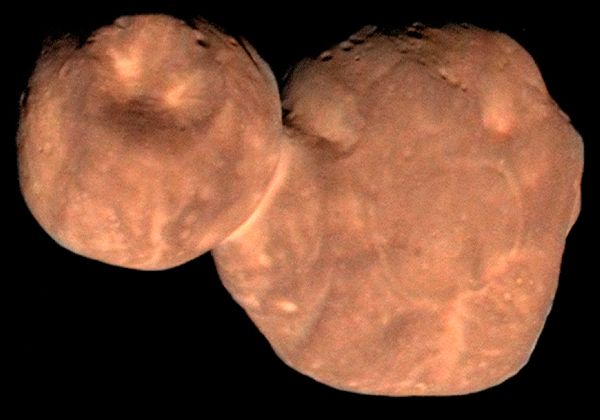
NASA / Johns Hopkins Applied Physics Laboratory / Southwest Research Institute, National Optical Astronomy Observatory
New Horizons Team Uncovers a Critical Piece of the Planetary Formation Puzzle (News Release)
Data from NASA’s New Horizons mission are providing new insights into how planets and planetesimals – the building blocks of the planets – were formed.
The New Horizons spacecraft flew past the ancient Kuiper Belt object Arrokoth (2014 MU69) on Jan. 1, 2019, providing humankind’s first close-up look at one of the icy remnants of solar system formation in the vast region beyond the orbit of Neptune. Using detailed data on the object’s shape, geology, color and composition – gathered during a record-setting flyby that occurred more than four billion miles from Earth – researchers have apparently answered a longstanding question about planetesimal origins, and therefore made a major advance in understanding how the planets themselves formed.
The team reports those findings in a set of three papers in the journal Science, and at a media briefing Feb. 13 at the annual American Association for the Advancement of Science meeting in Seattle.
“Arrokoth is the most distant, most primitive and most pristine object ever explored by spacecraft, so we knew it would have a unique story to tell,” said New Horizons Principal Investigator Alan Stern, of the Southwest Research Institute in Boulder, Colorado. “It’s teaching us how planetesimals formed, and we believe the result marks a significant advance in understanding overall planetesimal and planet formation.”
The first post-flyby images transmitted from New Horizons last year showed that Arrokoth had two connected lobes, a smooth surface and a uniform composition, indicating it was likely pristine and would provide decisive information on how bodies like it formed. These first results were published in Science last May.
“This is truly an exciting find for what is already a very successful and history-making mission” said Lori Glaze, director of NASA's Planetary Science Division. “The continued discoveries of NASA’s New Horizons spacecraft astound as it reshapes our knowledge and understanding of how planetary bodies form in solar systems across the universe.”
Over the following months, working with more and higher-resolution data as well as sophisticated computer simulations, the mission team assembled a picture of how Arrokoth must have formed. Their analysis indicates that the lobes of this “contact binary” object were once separate bodies that formed close together and at low velocity, orbited each other, and then gently merged to create the 22-mile long object New Horizons observed.
This indicates Arrokoth formed during the gravity-driven collapse of a cloud of solid particles in the primordial solar nebula, rather than by the competing theory of planetesimal formation called hierarchical accretion. Unlike the high-speed collisions between planetesimals in hierarchical accretion, in particle-cloud collapse, particles merge gently, slowly growing larger.
“Just as fossils tell us how species evolved on Earth, planetesimals tell us how planets formed in space,” said William McKinnon, a New Horizons co-investigator from Washington University in St. Louis, and lead author of an Arrokoth formation paper in Science this week. “Arrokoth looks the way it does not because it formed through violent collisions, but in more of an intricate dance, in which its component objects slowly orbited each other before coming together.”
Two other important pieces of evidence support this conclusion. The uniform color and composition of Arrokoth’s surface shows the KBO formed from nearby material, as local cloud collapse models predict, rather than a mishmash of matter from more separated parts of the nebula, as hierarchical models might predict.
The flattened shapes of each of Arrokoth’s lobes, as well as the remarkably close alignment of their poles and equators, also point to a more orderly merger from a collapse cloud. Further still, Arrokoth’s smooth, lightly cratered surface indicates its face has remained well preserved since the end of the planet formation era.
“Arrokoth has the physical features of a body that came together slowly, with ‘local’ materials in the solar nebula,” said Will Grundy, New Horizons composition theme team lead from Lowell Observatory in Flagstaff, Arizona, and the lead author of a second Science paper. “An object like Arrokoth wouldn’t have formed, or look the way it does, in a more chaotic accretion environment.”
The latest Arrokoth reports significantly expand on the May 2019 Science paper, led by Stern. The three new papers are based on 10 times as much data as the first report, and together provide a far more complete picture of Arrokoth’s origin.
“All of the evidence we’ve found points to particle-cloud collapse models, and all but rule out hierarchical accretion for the formation mode of Arrokoth, and by inference, other planetesimals,” Stern said.
New Horizons continues to carry out new observations of additional Kuiper Belt objects it passes in the distance. New Horizons also continues to map the charged-particle radiation and dust environment in the Kuiper Belt. The new KBOs being observed now are too far away to reveal discoveries like those on Arrokoth, but the team can measure aspects such as each object's surface properties and shape. This summer the mission team will begin using large groundbased telescopes to search for new KBOs to study in this way, and even for another flyby target if fuel allows.
The New Horizons spacecraft is now 4.4 billion miles (7.1 billion kilometers) from Earth, operating normally and speeding deeper into the Kuiper Belt at nearly 31,300 miles (50,400 kilometers) per hour.
The Johns Hopkins University Applied Physics Laboratory in Laurel, Maryland, designed, built and operates the New Horizons spacecraft, and manages the mission for NASA's Science Mission Directorate. The Marshall Space Flight Center Planetary Management Office provides the NASA oversight for the New Horizons. Southwest Research Institute, based in San Antonio, directs the mission via Principal Investigator Stern, and leads the science team, payload operations and encounter science planning. New Horizons is part of the New Frontiers Program managed by NASA's Marshall Space Flight Center in Huntsville, Alabama.
Source: NASA.Gov
****

No comments:
Post a Comment